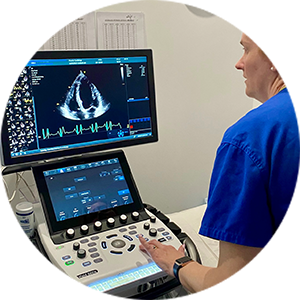Exercise Stress Echocardiogram
The Exercise Stress Echocardiogram measures the function of the heart, lungs and blood vessels. It is done to help diagnose blocked arteries in the heart (coronary artery disease) and also provide specific information about valvular disease and pressure in the heart and lungs.
There are two parts to this test. First, a Sonographer performs an echocardiogram using an ultrasound machine. An echocardiogram checks how your heart functions when resting. You lie on your left side. To ensure good contact between your skin and the probe, surgical gel is placed at several different sites on your chest. During this part of the test you hear loud swishing noises. This is the blood flowing through the valves of your heart. In the second part of the test, your heart is exercised or ‘stressed’. If you can walk easily, you can walk on the treadmill. The speed and slope of the treadmill will increase every 3 minutes. This makes your heart do more work and you will exercise quite hard. The test will be stopped if you have chest pain, become very tired or very short of breath (puffed). When your heart is working as hard as possible, you stop exercising and quickly lie down on the bed. More echocardiogram pictures are taken. If you feel unwell you should tell staff at once.
If you have difficulty walking, the doctor may decide to use a drug called ‘Dobutamine’ and undertake a Dobutamine Stress test. A Dobutamine stress test is not undertaken in the medical rooms of Dr Andrew Small. He will refer you to a Cardiology testing centre that undertakes this type of procedure.
You may have been referred for a Focused Exercise Stress Echocardiogram or a Comprehensive Exercise Stress Echocardiogram. Your doctor will have referred you for the particular test that meets the requirements for your investigation, diagnosis and treatment and be based within the Medicare guidelines.
A Comprehensive Exercise Stress Echocardiogram will take about 1 hour.
A Focused Exercise Stress Echocardiogram will take about 45 minutes.

Before your procedure:
- Eat a light snack and only drink water 2-3 hours before.
- Do not do any strenuous exercise on the day of the procedure.
- Stop your Beta blockers 24hrs prior to the ESE unless advised otherwise by your Cardiologist. These can include any of the following:
- Metoprolol
- Atenolol
- Bisoprolol
- Nebrivolol
- Propranolol
- Tropol-XL
- Carvedilol.
- Read and follow any other instructions or information given to you by your doctor/hospital.
- Wear shorts, pants or a skirt suitable for exercising in.
- Wear comfortable non-slip shoes suitable for walking.
The Sonographer will discuss the consent for the test with you prior to commencing the ESE. They will also weigh you, check your height and Blood Pressure.
The Sonographer will put some thick gel on your chest then using an ultrasound transducer (probe) will move the probe across your chest firmly to send and receive sounds waves from your heart.
You will then be asked to move to the treadmill. Your cardiologist will then assist with overseeing the stress part of the echocardiogram. When your heart has been exercised sufficiently (usually about 7-10minutes) you will be asked to quickly move to the bed and the Sonographer will continue to ultrasound your heart whilst it is beating under ‘stress’.
Usually after the procedure you will see your cardiologist for a consult to discuss the outcome of the Exercise Stress Echo. A formal report will also be sent to your referring doctor and/or GP.
